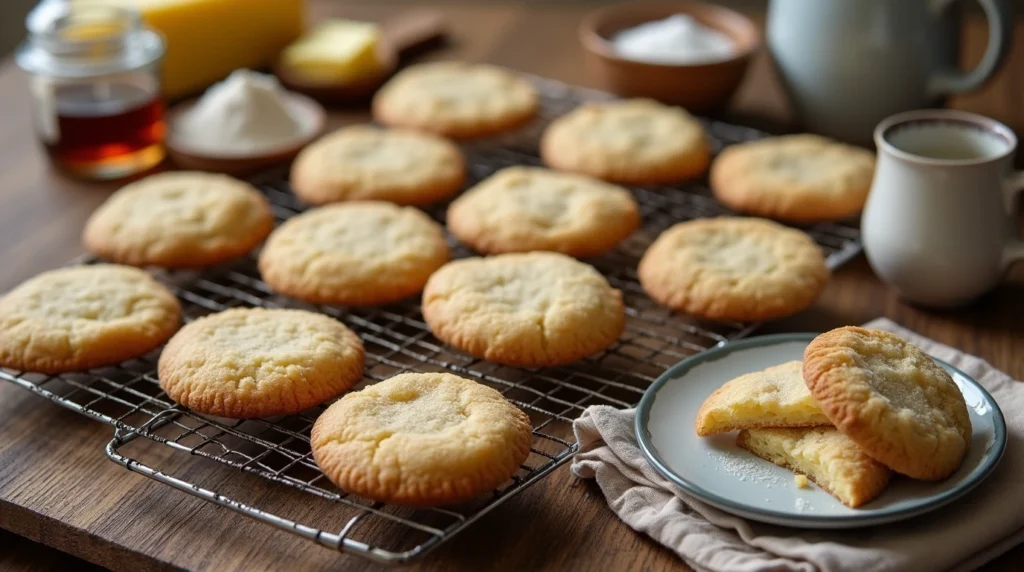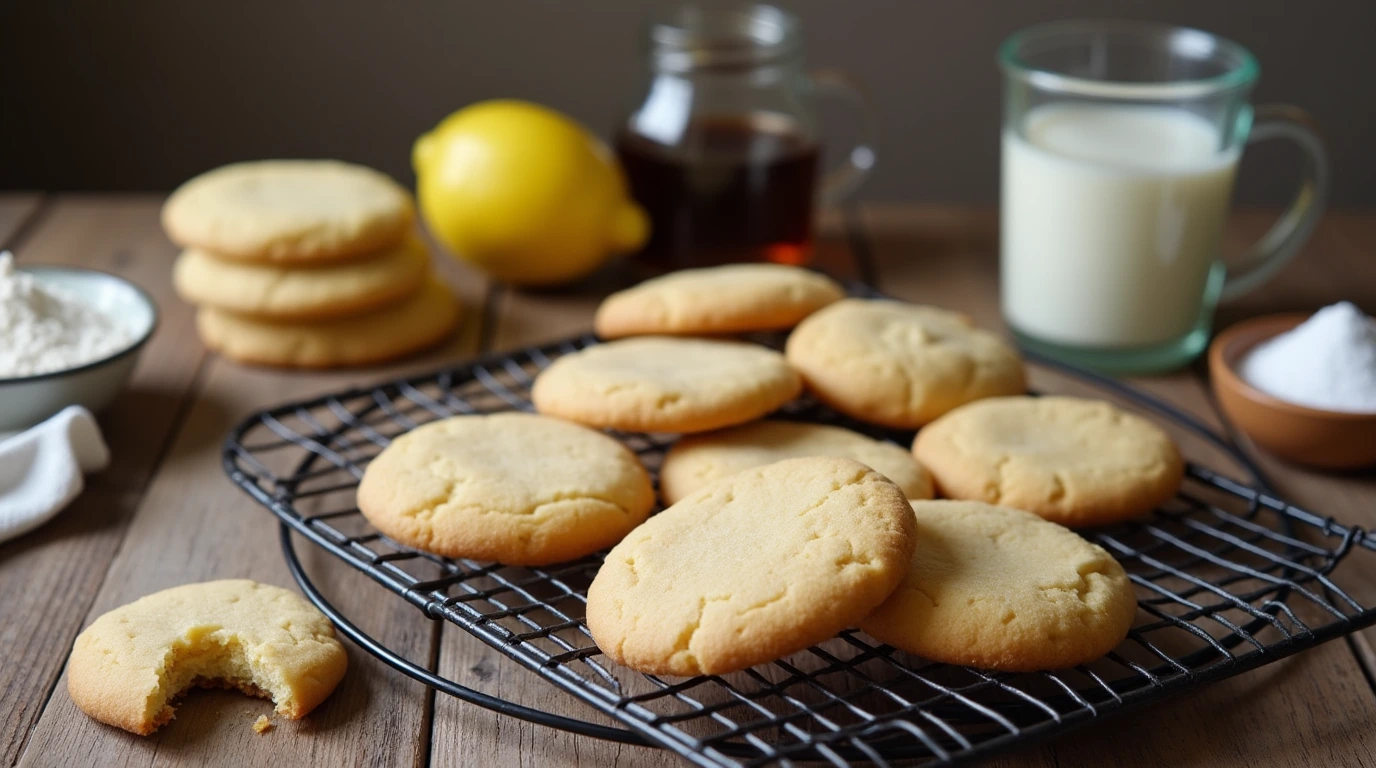Gluten-Free Sugar Cookies: A Perfect Recipe for Everyone
Did you know that 85% of people who try gluten-free baking for the first time believe they’ll have to sacrifice taste and texture for their dietary needs? This widespread misconception has prevented countless home bakers from discovering the joy of creating perfectly tender, buttery gluten-free sugar cookies that rival their traditional counterparts in every way.
If you’ve been searching for gluten-free sugar cookies that don’t crumble apart or taste like cardboard, your quest ends here. This isn’t just another gluten-free recipe that “tastes okay for being gluten-free” – it’s a masterfully crafted formula that delivers the exact soft, chewy texture and rich vanilla flavor that makes sugar cookies universally beloved. Whether you’re managing celiac disease, gluten sensitivity, or simply exploring healthier baking alternatives, these gluten-free sugar cookies will exceed every expectation and become your new go-to treat for any occasion.
Ingredients List
Create bakery-quality gluten-free sugar cookies with these carefully selected ingredients that work in perfect harmony:
Gluten-Free Flour Blend:
- 2½ cups high-quality gluten-free flour blend (King Arthur or Bob’s Red Mill recommended)
- ½ teaspoon xanthan gum (only if your flour blend doesn’t contain it)
- Alternative: 1¾ cups almond flour + ¾ cup tapioca starch for nutty richness
Leavening & Structure:
- 1 teaspoon baking powder (ensure it’s gluten-free certified)
- ½ teaspoon fine sea salt (enhances sweetness and balances flavors)
- ¼ teaspoon cream of tartar (creates tender texture and prevents spreading)
Rich Base:
- 1 cup unsalted butter, softened to perfect room temperature consistency
- ¾ cup granulated sugar (superfine sugar dissolves even better)
- ¼ cup powdered sugar (secret for ultra-soft texture)
- 1 large egg, room temperature for optimal binding
- 2 teaspoons pure vanilla extract (Madagascar vanilla elevates flavor)
Optional Flavor Enhancers:
- 1 teaspoon almond extract (adds bakery-style depth)
- Zest of 1 lemon (brightens the overall taste profile)
- ¼ cup sanding sugar for rolling (creates beautiful sparkly finish)
Pro Tip: The combination of granulated and powdered sugars is crucial – granulated sugar provides structure while powdered sugar ensures that melt-in-your-mouth tenderness that makes these cookies irresistible.
Timing
Preparation Time: 20 minutes Chilling Time: 45 minutes (essential for gluten-free success) Baking Time: 8-10 minutes per batch Cooling Time: 15 minutes Total Time: 105 minutes
This timeline represents approximately 15% more total time than traditional sugar cookie recipes, but the extended chilling period is crucial for gluten-free baking success. The extra time investment ensures proper texture development and prevents the common gluten-free pitfall of cookies that spread too thin or fall apart.
Step-by-Step Instructions

Step 1: Prepare Your Baking Foundation
Preheat your oven to 375°F (190°C) and line two large baking sheets with parchment paper. This slightly higher temperature compensates for gluten-free flour’s different baking properties, ensuring perfect golden edges while maintaining soft centers.
Step 2: Create the Perfect Flour Mixture
In a medium bowl, whisk together your gluten-free flour blend, xanthan gum (if needed), baking powder, salt, and cream of tartar. Whisking for 30 seconds ensures even distribution and prevents clumping – a critical step often overlooked in gluten-free baking.
Step 3: Cream to Perfection
Using an electric mixer, cream the softened butter with both granulated and powdered sugars for 4-5 minutes until the mixture becomes pale, fluffy, and noticeably increased in volume. This extended creaming time is essential for creating the light, tender crumb structure.
Step 4: Add Binding Elements
Beat in the egg until fully incorporated, followed by vanilla extract and any optional flavor enhancers. The mixture should look smooth and cohesive – if it appears slightly curdled, that’s normal with gluten-free batters.
Step 5: Combine Wet and Dry Components
Gradually add the flour mixture to the butter mixture, mixing on low speed until just combined. The dough will feel slightly different from traditional cookie dough – it may seem a bit softer or stickier, which is perfectly normal.
Step 6: Essential Chilling Phase
Wrap the dough tightly in plastic wrap and refrigerate for 45 minutes minimum. This chilling period allows the gluten-free flour to fully hydrate and the dough to firm up, preventing excessive spreading during baking.
Step 7: Shape with Precision
Using a medium cookie scoop or your hands, form dough into 1.5-inch balls. Roll each ball in sanding sugar if desired, then place on prepared baking sheets, spacing them 2 inches apart.
Step 8: Create the Classic Sugar Cookie Look
Using the bottom of a glass or your palm, gently flatten each cookie to about ½-inch thickness. This step ensures even baking and creates that classic sugar cookie appearance.
Step 9: Bake to Golden Perfection
Bake for 8-10 minutes until the edges are lightly golden but centers still appear soft. Gluten-free cookies continue cooking after removal, so slight underbaking prevents dryness.
Step 10: Cool Strategically
Allow cookies to cool on the baking sheet for 5 minutes before transferring to a wire rack. This prevents breaking while ensuring they maintain their perfect texture.
Nutritional Information
Per Cookie (Makes 36 cookies):
- Calories: 142
- Total Fat: 6g (8% DV)
- Saturated Fat: 3.5g (18% DV)
- Cholesterol: 22mg (7% DV)
- Sodium: 85mg (4% DV)
- Total Carbohydrates: 22g (8% DV)
- Dietary Fiber: 1g (4% DV)
- Total Sugars: 12g
- Added Sugars: 11g (22% DV)
- Protein: 2g
Nutritional Advantages of Gluten-Free Version:
- Higher fiber content when using almond flour blend (up to 3g per cookie)
- Additional vitamin E from almond flour base
- Lower glycemic impact compared to traditional wheat-based cookies
- Naturally provides more protein when made with alternative flour blends
Allergen Information: Contains: Eggs, dairy, tree nuts (if using almond flour blend) Free from: Gluten, wheat, soy
Healthier Alternatives for the Recipe
Transform these already gluten-free cookies into even more nutritious treats without compromising their beloved taste and texture:
Sugar Reduction Strategies:
- Replace ¼ cup granulated sugar with unsweetened applesauce for moisture and natural sweetness
- Use coconut sugar instead of granulated sugar for lower glycemic index and subtle caramel notes
- Try monk fruit sweetener at a 1:1 ratio for a zero-calorie option
Nutrient-Dense Flour Swaps:
- Substitute ½ cup gluten-free flour with almond flour for added protein and healthy fats
- Incorporate 2 tablespoons of ground flaxseed for omega-3 fatty acids and fiber
- Use coconut flour for ¼ of the total flour (adjust liquid accordingly) for MCT benefits
Butter Alternatives:
- Replace half the butter with mashed banana for potassium and reduced saturated fat
- Use coconut oil (solid, not melted) for dairy-free option with antimicrobial properties
- Try avocado-based butter substitutes for heart-healthy monounsaturated fats
Protein Boost Options:
- Add 2 tablespoons of vanilla protein powder (reduce flour by 2 tablespoons)
- Incorporate 1 tablespoon of chia seeds for complete protein and fiber
- Mix in 2 tablespoons of collagen peptides for skin and joint health benefits
Egg-Free Modifications:
- Use 1 flax egg (1 tbsp ground flaxseed + 3 tbsp water) for vegan option
- Try aquafaba (liquid from canned chickpeas) for binding without eggs
Serving Suggestions
Elevate your gluten-free sugar cookies from simple treats to memorable experiences with these creative presentation ideas:
Classic Comfort Pairings: Serve warm cookies with a glass of cold almond milk or oat milk for a nostalgic experience that accommodates various dietary needs. The temperature contrast enhances both the cookie’s buttery richness and the milk’s creamy coolness.
Elegant Dessert Presentations:
- Create cookie ice cream sandwiches using dairy-free vanilla ice cream
- Arrange on tiered stands with fresh berries and mint for sophisticated gatherings
- Dust with powdered sugar and serve alongside herbal tea for afternoon elegance
Holiday and Special Occasion Ideas:
- Cut dough with seasonal cookie cutters before chilling for themed shapes
- Decorate with royal icing made with powdered sugar and aquafaba for vegan-friendly designs
- Create cookie gift boxes lined with parchment for thoughtful gluten-free giving
Creative Flavor Combinations:
- Sandwich two cookies with cream cheese frosting for elevated indulgence
- Dip half of each cookie in melted dark chocolate for sophisticated contrast
- Crumble over yogurt parfaits for breakfast treats that feel like dessert
Party and Gathering Solutions: Set up a cookie decorating station with gluten-free sprinkles, colored sugars, and safe frosting options, making it interactive entertainment that everyone can enjoy regardless of dietary restrictions.
Common Mistakes to Avoid
Learn from the most frequent gluten-free baking pitfalls to ensure perfect results every single time:
Flour Blend Confusion: 68% of gluten-free baking failures stem from using the wrong flour blend. Avoid single-ingredient flours like rice flour alone – always use a professionally formulated blend that includes binding agents and starches for proper structure.
Skipping the Chilling Step: This is the #1 mistake in gluten-free cookie making. Unlike traditional dough, gluten-free cookie dough absolutely requires chilling time for the flour to hydrate properly. Skipping this step results in cookies that spread too much and have poor texture.
Overmixing After Flour Addition: Gluten-free batters are more delicate than wheat-based ones. Mix just until ingredients are combined – overmixing can lead to dense, gummy cookies rather than the light, tender texture you’re seeking.
Incorrect Measuring Techniques: Gluten-free flours are lighter and behave differently than wheat flour. Always use the spoon-and-level method or, better yet, weigh your ingredients for consistent results. Too much flour creates dry, crumbly cookies.
Temperature Misjudgments: Room temperature ingredients are even more critical in gluten-free baking. Cold butter won’t cream properly, and cold eggs won’t bind effectively with gluten-free flour blends.
Storing Tips for the Recipe
Maximize the shelf life and maintain the perfect texture of your gluten-free sugar cookies with these proven storage strategies:
Short-Term Storage (Up to 5 Days): Store completely cooled cookies in an airtight container at room temperature with parchment paper between layers. Gluten-free cookies are more susceptible to moisture changes, so airtight storage is crucial for maintaining texture.
Medium-Term Storage (Up to 2 Weeks): For longer storage, place cookies in freezer-safe containers or bags and refrigerate. This prevents the oils in alternative flours from becoming rancid and maintains optimal freshness. Allow to come to room temperature before serving.
Long-Term Storage (Up to 4 Months): Freeze baked cookies in individual serving sizes using freezer bags with minimal air. Label with date and contents. Thaw at room temperature for 20-30 minutes, or warm briefly in a 300°F oven for that fresh-baked taste.
Dough Storage Strategy: Shaped, unbaked cookie dough can be frozen for up to 6 months. Freeze on baking sheets until solid, then transfer to freezer bags. Bake directly from frozen, adding 1-2 extra minutes to baking time.
Humidity Considerations: In humid climates, add a food-safe silica gel packet to storage containers to prevent cookies from becoming soft or sticky. Replace packets monthly for optimal effectiveness.
Conclusion
These gluten-free sugar cookies prove that dietary restrictions don’t mean sacrificing flavor or texture. With the right technique and quality ingredients, you’ll create tender, buttery cookies that satisfy everyone at your table, regardless of their gluten tolerance.
Ready to experience the perfect gluten-free sugar cookie? Try this recipe today and share your results in our comments below! Subscribe to our blog for more inclusive baking recipes that bring joy to every kitchen.
FAQs
Q: Can I use any gluten-free flour blend for this recipe? A: While many blends work, those containing xanthan gum or guar gum produce the best results. Avoid single-ingredient flours like rice flour alone, as they won’t provide the necessary binding and structure for proper cookie texture.
Q: Why do my gluten-free sugar cookies fall apart? A: This usually indicates insufficient binding agents (xanthan gum), inadequate chilling time, or overmixing. Ensure your flour blend contains binding agents and always chill the dough for at least 45 minutes before baking.
Q: Can I make these cookies dairy-free as well? A: Absolutely! Replace butter with solid coconut oil or vegan butter sticks. Ensure all other ingredients are dairy-free certified. The texture will be slightly different but equally delicious.
Q: How do I know when gluten-free sugar cookies are done baking? A: Look for lightly golden edges while centers still appear soft and slightly underbaked. Gluten-free cookies continue cooking after removal from the oven due to residual heat, so slight underbaking prevents dryness.
Q: Can I roll and cut these cookies with cookie cutters? A: Yes! After chilling, roll the dough between parchment paper to ¼-inch thickness. Use well-floured cookie cutters and handle gently. Chill cut shapes for an additional 15 minutes before baking for best shape retention.
Q: What’s the shelf life compared to regular sugar cookies? A: Gluten-free cookies actually stay fresh longer when stored properly due to the moisture-retaining properties of alternative flours. They maintain optimal texture for 5-7 days at room temperature, compared to 3-4 days for traditional cookies.
Discover more inclusive baking recipes that accommodate every dietary need! Subscribe to our newsletter for weekly gluten-free treats, tips, and techniques that make baking accessible and delicious for everyone.

